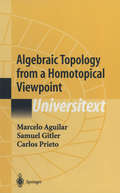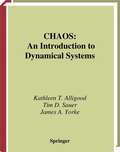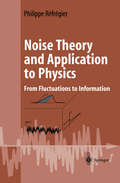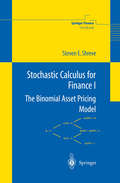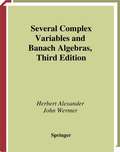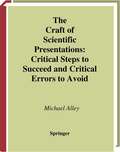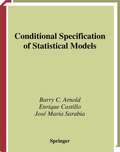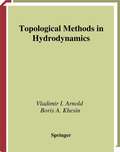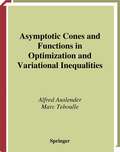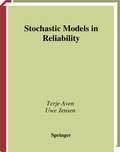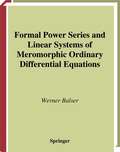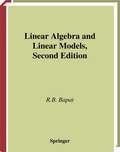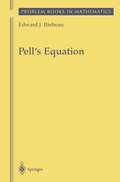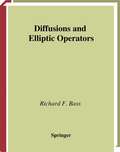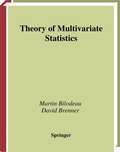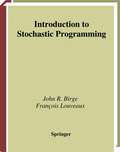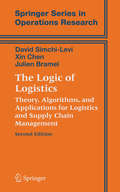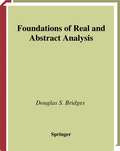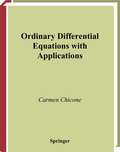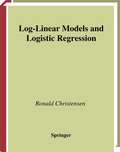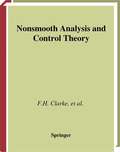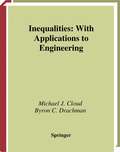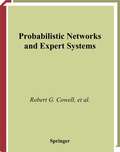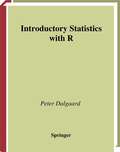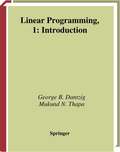- Table View
- List View
Algebraic Topology from a Homotopical Viewpoint (Universitext)
by Marcelo Aguilar Samuel Gitler Carlos PrietoThe authors present introductory material in algebraic topology from a novel point of view in using a homotopy-theoretic approach. This carefully written book can be read by any student who knows some topology, providing a useful method to quickly learn this novel homotopy-theoretic point of view of algebraic topology.
Chaos: An Introduction to Dynamical Systems (Textbooks in Mathematical Sciences)
by Kathleen T. Alligood Tim D. Sauer James A. YorkeDeveloped and class-tested by a distinguished team of authors at two universities, this text is intended for courses in nonlinear dynamics in either mathematics or physics. The only prerequisites are calculus, differential equations, and linear algebra. Along with discussions of the major topics, including discrete dynamical systems, chaos, fractals, nonlinear differential equations and bifurcations, the text also includes Lab Visits -- short reports that illustrate relevant concepts from the physical, chemical and biological sciences. There are Computer Experiments throughout the text that present opportunities to explore dynamics through computer simulations, designed for use with any software package. And each chapter ends with a Challenge, guiding students through an advanced topic in the form of an extended exercise.
Noise Theory and Application to Physics: From Fluctuations to Information (Advanced Texts in Physics)
by Philippe RéfrégierThis is a unique approach to noise theory and its application to physical measurements that will find its place among the graduate course books. In a very systematic way, the foundations are laid and applied in a way that the book will also be useful to those not focusing on optics. Exercises and solutions help students to deepen their knowledge.
Stochastic Calculus for Finance I: The Binomial Asset Pricing Model (Springer Finance)
by Steven ShreveDeveloped for the professional Master's program in Computational Finance at Carnegie Mellon, the leading financial engineering program in the U.S. Has been tested in the classroom and revised over a period of several years Exercises conclude every chapter; some of these extend the theory while others are drawn from practical problems in quantitative finance
Several Complex Variables and Banach Algebras (Graduate Texts in Mathematics #35)
by Herbert Alexander John WermerA development of some of the principal applications of function theory in several complex variables to Banach algebras. The authors do not presuppose any knowledge of several complex variables on the part of the reader, and all relevant material is developed within the text. Furthermore, the book deals with problems of uniform approximation on compact subsets of the space of n complex variables. This third edition contains new material on maximum modulus algebras and subharmonicity, the hull of a smooth curve, integral kernels, perturbations of the Stone-Weierstrass Theorem, boundaries of analytic varieties, polynomial hulls of sets over the circle, areas, and the topology of hulls. The authors have also included a new chapter commenting on history and recent developments, as well as an updated and expanded reading list.
The Craft of Scientific Presentations: Critical Steps to Succeed and Critical Errors to Avoid
by Michael AlleyThis timely and hugely practical work provides a score of examples from contemporary and historical scientific presentations to show clearly what makes an oral presentation effective. It considers presentations made to persuade an audience to adopt some course of action (such as funding a proposal) as well as presentations made to communicate information, and it considers these from four perspectives: speech, structure, visual aids, and delivery. It also discusses computer-based projections and slide shows as well as overhead projections. In particular, it looks at ways of organizing graphics and text in projected images and of using layout and design to present the information efficiently and effectively.
Conditional Specification of Statistical Models (Springer Series in Statistics)
by Barry C. Arnold Enrique Castillo Jose M. SarabiaEfforts to visualize multivariate densities necessarily involve the use of cross-sections, or, equivalently, conditional densities. This book focuses on distributions that are completely specified in terms of conditional densities. They are appropriately used in any modeling situation where conditional information is completely or partially available. All statistical researchers seeking more flexible models than those provided by classical models will find conditionally specified distributions of interest.
Topological Methods in Hydrodynamics (Applied Mathematical Sciences #125)
by Vladimir I. Arnold Boris A. KhesinThe first monograph to treat topological, group-theoretic, and geometric problems of ideal hydrodynamics and magnetohydrodynamics from a unified point of view. It describes the necessary preliminary notions both in hydrodynamics and pure mathematics with numerous examples and figures. The book is accessible to graduates as well as pure and applied mathematicians working in hydrodynamics, Lie groups, dynamical systems, and differential geometry.
Asymptotic Cones and Functions in Optimization and Variational Inequalities (Springer Monographs in Mathematics)
by Alfred Auslender Marc TeboulleThis systematic and comprehensive account of asymptotic sets and functions develops a broad and useful theory in the areas of optimization and variational inequalities. The central focus is on problems of handling unbounded situations, using solutions of a given problem in these classes, when for example standard compacity hypothesis is not present. This book will interest advanced graduate students, researchers, and practitioners of optimization theory, nonlinear programming, and applied mathematics.
Stochastic Models in Reliability (Stochastic Modelling and Applied Probability #41)
by Terje Aven Uwe JensenA comprehensive up-to-date presentation of some of the classical areas of reliability, based on a more advanced probabilistic framework using the modern theory of stochastic processes. This framework allows analysts to formulate general failure models, establish formulae for computing various performance measures, as well as determine how to identify optimal replacement policies in complex situations.
Formal Power Series and Linear Systems of Meromorphic Ordinary Differential Equations (Universitext)
by Werner BalserSimple Ordinary Differential Equations may have solutions in terms of power series whose coefficients grow at such a rate that the series has a radius of convergence equal to zero. In fact, every linear meromorphic system has a formal solution of a certain form, which can be relatively easily computed, but which generally involves such power series diverging everywhere. In this book the author presents the classical theory of meromorphic systems of ODE in the new light shed upon it by the recent achievements in the theory of summability of formal power series.
Linear Algebra and Linear Models (Universitext)
by Ravindra B. BapatThis book provides a rigorous introduction to the basic aspects of the theory of linear estimation and hypothesis testing, covering the necessary prerequisites in matrices, multivariate normal distribution and distributions of quadratic forms along the way. It will appeal to advanced undergraduate and first-year graduate students, research mathematicians and statisticians.
Pell’s Equation (Problem Books in Mathematics)
by Edward J. BarbeauPell's equation is part of a central area of algebraic number theory that treats quadratic forms and the structure of the rings of integers in algebraic number fields. It is an ideal topic to lead college students, as well as some talented and motivated high school students, to a better appreciation of the power of mathematical technique. Even at the specific level of quadratic diophantine equations, there are unsolved problems, and the higher degree analogues of Pell's equation, particularly beyond the third, do not appear to have been well studied. In this focused exercise book, the topic is motivated and developed through sections of exercises which will allow the readers to recreate known theory and provide a focus for their algebraic practice. There are several explorations that encourage the reader to embark on their own research. A high school background in mathematics is all that is needed to get into this book, and teachers and others interested in mathematics who do not have (or have forgotten) a background in advanced mathematics may find that it is a suitable vehicle for keeping up an independent interest in the subject.
Diffusions and Elliptic Operators (Probability and Its Applications)
by Richard F. BassA discussion of the interplay of diffusion processes and partial differential equations with an emphasis on probabilistic methods. It begins with stochastic differential equations, the probabilistic machinery needed to study PDE, and moves on to probabilistic representations of solutions for PDE, regularity of solutions and one dimensional diffusions. The author discusses in depth two main types of second order linear differential operators: non-divergence operators and divergence operators, including topics such as the Harnack inequality of Krylov-Safonov for non-divergence operators and heat kernel estimates for divergence form operators, as well as Martingale problems and the Malliavin calculus. While serving as a textbook for a graduate course on diffusion theory with applications to PDE, this will also be a valuable reference to researchers in probability who are interested in PDE, as well as for analysts interested in probabilistic methods.
Theory of Multivariate Statistics (Springer Texts in Statistics)
by Martin Bilodeau David BrennerIntended as a textbook for students taking a first graduate course in the subject, as well as for the general reference of interested research workers, this text discusses, in a readable form, developments from recently published work on certain broad topics not otherwise easily accessible, such as robust inference and the use of the bootstrap in a multivariate setting. A minimum background expected of the reader would include at least two courses in mathematical statistics, and certainly some exposure to the calculus of several variables together with the descriptive geometry of linear algebra.
Introduction to Stochastic Programming (Springer Series in Operations Research and Financial Engineering)
by John R. Birge François LouveauxThis rapidly developing field encompasses many disciplines including operations research, mathematics, and probability. Conversely, it is being applied in a wide variety of subjects ranging from agriculture to financial planning and from industrial engineering to computer networks. This textbook provides a first course in stochastic programming suitable for students with a basic knowledge of linear programming, elementary analysis, and probability. The authors present a broad overview of the main themes and methods of the subject, thus helping students develop an intuition for how to model uncertainty into mathematical problems, what uncertainty changes bring to the decision process, and what techniques help to manage uncertainty in solving the problems. The early chapters introduce some worked examples of stochastic programming, demonstrate how a stochastic model is formally built, develop the properties of stochastic programs and the basic solution techniques used to solve them. The book then goes on to cover approximation and sampling techniques and is rounded off by an in-depth case study. A well-paced and wide-ranging introduction to this subject.
The Logic of Logistics: Theory, Algorithms, and Applications for Logistics and Supply Chain Management (Springer Series in Operations Research and Financial Engineering)
by David Simchi-Levi Xin Chen Julien BramelFierce competition in today's global market provides a powerful motivation for developing ever more sophisticated logistics systems. This book, written for the logistics manager and researcher, presents a survey of the modern theory and application of logistics. The goal of the book is to present the state-of-the-art in the science of logistics management. As a result, the authors have written a timely and authoritative survey of this field that many practitioners and researchers will find makes an invaluable companion to their work.
Foundations of Real and Abstract Analysis (Graduate Texts in Mathematics #174)
by Douglas S. BridgesA complete course on metric, normed, and Hilbert spaces, including many results and exercises seldom found in texts on analysis at this level. The author covers an unusually wide range of material in a clear and concise format, including elementary real analysis, Lebesgue integration on R, and an introduction to functional analysis. The book begins with a fast-paced course on real analysis, followed by an introduction to the Lebesgue integral. This provides a reference for later chapters as well as a preparation for students with only the typical sequence of undergraduate calculus courses as prerequisites. Other features include a chapter introducing functional analysis, the Hahn-Banach theorem and duality, separation theorems, the Baire Category Theorem, the Open Mapping Theorem and their consequences, and unusual applications. Of special interest are the 750 exercises, many with guidelines for their solutions, applications and extensions of the main propositions and theorems, pointers to new branches of the subject, and difficult challenges for the very best students.
Ordinary Differential Equations with Applications (Texts in Applied Mathematics #34)
by Carmen ChiconeBased on a one-year course taught by the author to graduates at the University of Missouri, this book provides a student-friendly account of some of the standard topics encountered in an introductory course of ordinary differential equations. In a second semester, these ideas can be expanded by introducing more advanced concepts and applications. A central theme in the book is the use of Implicit Function Theorem, while the latter sections of the book introduce the basic ideas of perturbation theory as applications of this Theorem. The book also contains material differing from standard treatments, for example, the Fiber Contraction Principle is used to prove the smoothness of functions that are obtained as fixed points of contractions. The ideas introduced in this section can be extended to infinite dimensions.
Log-Linear Models and Logistic Regression (Springer Texts in Statistics)
by Ronald ChristensenThe primary focus here is on log-linear models for contingency tables, but in this second edition, greater emphasis has been placed on logistic regression. The book explores topics such as logistic discrimination and generalised linear models, and builds upon the relationships between these basic models for continuous data and the analogous log-linear and logistic regression models for discrete data. It also carefully examines the differences in model interpretations and evaluations that occur due to the discrete nature of the data. Sample commands are given for analyses in SAS, BMFP, and GLIM, while numerous data sets from fields as diverse as engineering, education, sociology, and medicine are used to illustrate procedures and provide exercises. Throughoutthe book, the treatment is designed for students with prior knowledge of analysis of variance and regression.
Nonsmooth Analysis and Control Theory (Graduate Texts in Mathematics #178)
by Francis H. Clarke Yuri S. Ledyaev Ronald J. Stern Peter R. WolenskiA clear and succinct presentation of the essentials of this subject, together with some of its applications and a generous helping of interesting exercises. Following an introductory chapter with a taste of what is to come, the next three chapters constitute a course in nonsmooth analysis and identify a coherent and comprehensive approach to the subject, leading to an efficient, natural, and powerful body of theory. The whole is rounded off with a self-contained introduction to the theory of control of ordinary differential equations. The authors have incorporated a number of new results which clarify the relationships between the different schools of thought in the subject, with the aim of making nonsmooth analysis accessible to a wider audience. End-of-chapter problems offer scope for deeper understanding.
Inequalities: With Applications to Engineering
by Michael J. Cloud Bryon C. DrachmanA working knowledge of inequalities can be beneficial to the practicing engineer, and inequalities are central to the definitions of all limiting processes, including differentiation and integration. When exact solutions are unavailable, inconvenient, or unnecessary, inequalities can be used to obtain error bounds for numerical approximation. They can also lead to an understanding of the qualitative behavior of solutions. This guide to inequalities was written specifically with engineers and other applied scientists in mind, and helps fill the gap between college algebra-level treatments, and the formidable treatise on the subject that exist in the mathematics literature. To consolidate the learning process, every chapter ends with a rich collection of exercises.
Probabilistic Networks and Expert Systems: Exact Computational Methods for Bayesian Networks (Information Science and Statistics)
by Robert G. Cowell Philip Dawid Steffen L. Lauritzen David J. SpiegelhalterProbabilistic expert systems are graphical networks which support the modeling of uncertainty and decisions in large complex domains, while retaining ease of calculation. Building on original research by the authors, this book gives a thorough and rigorous mathematical treatment of the underlying ideas, structures, and algorithms. The book will be of interest to researchers in both artificial intelligence and statistics, who desire an introduction to this fascinating and rapidly developing field. The book, winner of the DeGroot Prize 2002, the only book prize in the field of statistics, is new in paperback.
Introductory Statistics with R (Statistics and Computing)
by Peter DalgaardThis book provides an elementary-level introduction to R, targeting both non-statistician scientists in various fields and students of statistics. The main mode of presentation is via code examples with liberal commenting of the code and the output, from the computational as well as the statistical viewpoint. Brief sections introduce the statistical methods before they are used. A supplementary R package can be downloaded and contains the data sets. All examples are directly runnable and all graphics in the text are generated from the examples. The statistical methodology covered includes statistical standard distributions, one- and two-sample tests with continuous data, regression analysis, one-and two-way analysis of variance, regression analysis, analysis of tabular data, and sample size calculations. In addition, the last four chapters contain introductions to multiple linear regression analysis, linear models in general, logistic regression, and survival analysis.
Linear Programming 1: Introduction (Springer Series in Operations Research and Financial Engineering)
by George B. Dantzig Mukund N. ThapaEncompassing all the major topics students will encounter in courses on the subject, the authors teach both the underlying mathematical foundations and how these ideas are implemented in practice. They illustrate all the concepts with both worked examples and plenty of exercises, and, in addition, provide software so that students can try out numerical methods and so hone their skills in interpreting the results. As a result, this will make an ideal textbook for all those coming to the subject for the first time. Authors' note: A problem recently found with the software is due to a bug in Formula One, the third party commercial software package that was used for the development of the interface. It occurs when the date, currency, etc. format is set to a non-United States version. Please try setting your computer date/currency option to the United States option . The new version of Formula One, when ready, will be posted on WWW.
